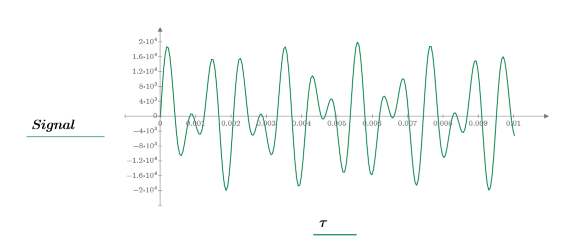Example: Signal Generation
Signal Synthesis
Consider a dual-tone multi-frequency (DTMF) signal. These signals are commonly used for touch tone telephone dialing and remote control functions. DTMF signals are composed of one high frequency and one low frequency sinusoidal signal. A table of common tones is shown below.
|
Digital Phone Keypad
|
High Tone Group
|
||||
|
1209 Hz
|
1336 Hz
|
1477 Hz
|
1633 Hz
|
||
|
Low
|
697 Hz
|
1
|
2
|
3
|
A
|
|
Tone
|
770 Hz
|
4
|
5
|
6
|
B
|
|
852 Hz
|
7
|
8
|
9
|
C
|
|
|
Group
|
941 Hz
|
*
|
0
|
#
|
D
|
For example, to generate the tone for the number 5 button, mix the 770 Hz signal from the Low Tone Group with the 1336 Hz signal from the High Tone Group.
In this example, use PTC Mathcad to generate the # tone.
1. Define the number of channels, sample rate and resolution.



2. Set the time duration and the number of data points.


3. Calculate the time interval and generate two arrays, one for indexing and one for time.



4. Set the amplitude of the signal and choose the two frequencies required to generate the # tone.



5. Use the sin function to generate the signal, and plot it.


6. Use the WRITEWAV function to write the signal to a WAV file using the specified parameters.

If the specified bit resolution is 1-8, the data is written to the file as unsigned byte data. The limits of unsigned byte data are 0-256 (28). If the bit resolution is 9-16, word data (two bytes) is written to the file. The limits on word data are –32768 - +32767 (215).
7. Try changing the frequencies for the DTMF signal and then play the sound file. The sound is similar to a touch-tone telephone.
Exponential Ramp in Frequency
Another useful signal in audio testing is the exponential ramp in frequency.
1. Define an exponential ramp in frequency signal.

2. Define the sample rate, the resolution, and the number of channels.



3. Define the following parameters for the new signal.








5. Use WRITEWAV to write the signal to a new file.

6. Plot the signal.
